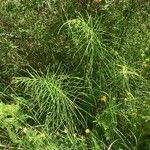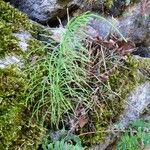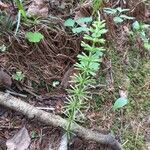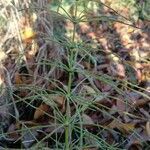Stems annual, dimorphic, the sterile ones 2–5 dm, 1–3 mm thick, smoothish toward the base, otherwise beset with high, blunt, siliceous tubercles or very short, high, transverse ridge-crests on the (6–)10–18 ridges, with rather small vallecular cavities and a fairly large central cavity commonly 1/3–1/2 the diameter of the stem, the stomates in 2 broad bands in each furrow; sheaths 2–6 cm, green, the teeth 1–2 mm, persistent, only basally connate, with pale, hyaline margins and a firmer dark midstripe; branches regularly whorled at the middle and upper nodes, solid, mostly 3-angled, simple, the first internode to as long as the associated stem-sheath; fertile stems with simple branches, otherwise as in E. sylvaticum. Streambanks and moist woods; circumboreal, s. in our range to N.J. and ne. Io.
Aerial stems dimorphic; vegetative stems green, branched, 16--50 cm; hollow center 1/6--1/3 stem diam. Sheaths somewhat elongate, 3--5 × 2--4 mm; teeth 8--18, narrow, 1.5--4 mm, centers dark and margins white. Branches in regular whorls, horizontal to drooping, solid; ridges 3; valleys channeled; 1st internode of each branch equal to or longer than subtending stem sheath; sheath teeth deltate. Fertile stems brown, with stomates, initially unbranched, persisting and becoming branched and green after spore discharge.
A medium sized herb.






